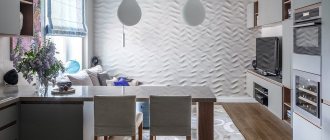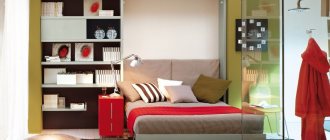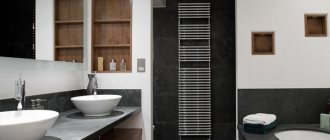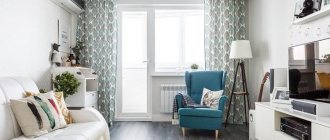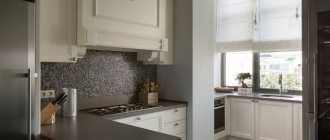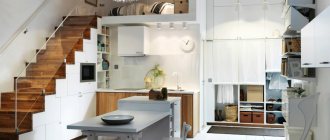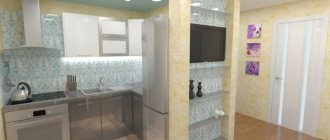Both happy owners of a studio apartment and less fortunate owners of small-sized urban dwellings often have to face the same problem - the need to delimit the space of the kitchen and dining room. In the first case, this is obvious: the common space in any case needs to be zoned. In the second, such a need arises when, in order to increase living space, massive interior partitions are removed, the kitchen is combined with a storage room and corridors, and so on.
The partition between the kitchen and living room serves several functions.
Purpose of the design
Why do you need a partition in the living room? Essentially, it does the same thing as a wall, that is, it separates one room from another. However, unlike the latter, the kitchen partition between the kitchen and the living room is much thinner and lighter, that is, it takes up less space and increases the living space.
The photo shows beautiful plasterboard partitions between the kitchen and dining room.
Partitions are made from a variety of materials; they can be very decorative and used as an interior design tool.
Structures can perform the following functions:
- zoning - the most obvious, required in a studio apartment or a combined dining room and kitchen . If finishing and placement of furniture groups is not enough for zoning, they resort to this technique;
- planning - such a partition, as a rule, occupies space from floor to ceiling and its purpose is to physically enclose the kitchen area . When cooking, odors are released, vapor appears, and humidity increases. They try to protect the dining room, and even more so the living room, from this. This can be done using a plasterboard partition between the kitchen and living room, a glass structure, a wooden one, and so on;
- functional - this kind of fencing does not save space, but it performs additional functions . The partition is combined with a cabinet, for example, or shelves, which allows it to be used as a storage place for dishes, utensils, and kitchen appliances;
- The decorative partition between the kitchen and living room serves as a design tool . Decorated in the style chosen for the living room interior. It also serves for zoning, but rather denotes the separation of zones than acts as a physical barrier.
The choice of design is made taking into account many factors. The most important thing is the area. So, with small sizes, a functional space is not installed, since it takes up a lot of space. The photo shows partitions between the kitchen and living room.
Types of partitions (3 options)
As we have already said, partitions can be stationary, mobile and soft. In this section we will take a closer look at the features of each type.
Stationary
A stationary partition between the living room and kitchen can be made of plasterboard, brick or glass blocks. The choice of material should be based on the characteristics of the room and your financial capabilities. Let's take a closer look at each of the options.
You can use a cabinet with kitchen utensils as a stationary partition.
- Drywall . The main advantages of drywall are its affordable price and ease of installation. You can easily install such a screen with your own hands, without having deep knowledge in the construction field. The disadvantages include poor sound insulation of the material.
The instructions for making plasterboard structures are simple and can be handled even without the proper experience.
- Brick . A brick partition will provide excellent sound insulation, and it can also become a great addition to a loft or minimalist interior. It’s just worth considering that due to the large weight of such a structure, its construction should be approved by the relevant authorities.
Brickwork will decorate an interior in a loft or minimalist style
- Glass blocks . In its properties, this material is close to brickwork. It allows you to create an unusual design and does not overload the space.
Glass blocks are made from incredibly strong glass, so they will be difficult to break.
Using these materials, you can create a partition from floor to ceiling or with a height of about a meter. It can separate zones on one side or almost completely block the passage. The choice is yours.
See also: Kitchen-living room design project - fresh ideas
Sliding
A sliding partition between the living room and kitchen allows you to make the most of all the features of the layout. When opened, it does not overload the space, but complements it; when closed, it prevents the spread of odors from the kitchen throughout the apartment. It is also worth mentioning that the design does not take up much space, and accordingly it can be used even in a small kitchen.
Sliding structures do not take up much space, but perform several useful functions
Speaking about the advantages of sliding partitions, it is necessary to note their functional characteristics. In principle, these are the same mobile sliding doors that help create two zones. It can be added that such an element of the interior design of the combined kitchen and living room is exclusive.
Glass screens make the space feel lighter
There are several types of sliding structures:
- Transparent . In this case, a large glass door is used as a screen. It is necessary to choose models made from impact-resistant triplex glass.
Durable triplex glass forms the basis of transparent partitions
- Opaque . Opaque structures can be made of plastic, MDF or chipboard. They are distinguished by a wide range of colors and texture imitations.
Structures made from MDF or chipboard have a wide range of colors
- Radial . They are considered the most sophisticated and modern option. Their curved appearance allows you to create a truly unusual design in the room. They cost much more than analogues made from other materials, but they also look much more impressive.
Radius designs look very impressive, but are only suitable for spacious rooms
Soft
Soft partitions between the living room and kitchen are a relatively new way of zoning space. They originate from exquisite screens that have been used in homes for many centuries.
Instead of a screen, you can use thick curtains
Soft structures consist of a rigid frame on which special wear-resistant textiles are stretched. The choice of colors and materials is more than extensive, which allows you to choose a partition to suit any interior style.
Choose the color for the fabric screen based on the existing interior
Soft partitions between the kitchen and living room are particularly mobile - they can not only be quickly installed, but also moved from place to place. In addition, they do not leave dents on the floor and ceiling.
Requirements for dividing structures
The partition in the living room does not act as a load-bearing wall. They can be installed without permission from the building management.
Depending on the purpose, the partition between the kitchen and living room instead of a wall must meet certain requirements:
- a structure enclosing only part of the kitchen area is allowed only if the kitchen uses an electric hob and oven. If a gas stove is installed, it is necessary to install a solid partition with sliding doors, for example;
- When cooking, steam is released, fat evaporates, and soot is formed. They settle on the walls, which leads to rapid wear of the material. Accordingly, the enclosing structure should be made of materials that are easy to clean - plastic, glass;
- preference is given to transparent or translucent materials, since in this case the space of the room is not visually reduced;
- even a decorative wall should be strong enough, especially if it is placed in the center of the room.
In the photo there is a partition between the kitchen and living room with a sliding door.
The kitchen-living room with a partition should be made in the same stylistic solution. Some difference in finish should not interfere with this.
Sequence of installation of partitions
As already noted, you can create beautiful partitions between the kitchen and living room from any materials. But most often they use plasterboard or options appropriate for sliding doors.
You can come up with an original version of the partition yourself
Construction of a plasterboard wall
You can make a partition from plasterboard by following a number of recommendations:
- First, you need to mark places on the floor and walls for mounting the frame, choosing suitable options for plasterboard partitions, and firmly fix the aluminum profile to the floor covering;
- After attaching the wall profile to the guide, it is leveled using a building level and screwed to the wall using special brackets;
- The profile is fixed on the ceiling, an electric cable is laid in the voids to create lighting, and sheets of drywall are attached;
- Before screwing the drywall on the opposite side, mineral wool or polystyrene foam is placed inside;
- After installation, the wall is puttied, sanded and finished.
Installation of a sliding structure
To separate the kitchen from the living room with a partition in the form of a sliding element, you need to choose the right material, choosing light and durable options, and purchase components in the form of guide elements and roller mechanisms. Sliding partitions can be installed with hinged or built-in mechanisms.
WATCH THE VIDEO
If the sliding doors between the kitchen and living room are made of fabric, plastic or other thin material, a frame is first formed from an aluminum profile or wooden slats. This stage is especially important when the opening width is more than 2 meters. When the preparatory work is completed, attach the compartment door to the kitchen to the components and check how freely it moves.
Structural solutions
You can separate the kitchen and dining room in different ways. Accordingly, the options for partitions between the kitchen and living room differ in a variety of ways.
- A false wall is the most common option, as it is the easiest to construct . Even a novice DIYer can separate the kitchen from the living room with a plasterboard partition. Unlike a real interior wall, a fake one is much thinner, that is, it takes up less space; can be combined with a cabinet, niches or shelving, for example, to combine two functions. The material of the false wall and its design are selected depending on the style of the main room. The design can be quite durable. Shelves, paintings, and even a TV are often placed on the partition. A very unusual option is when a false wall niche is used to install an aquarium or terrarium.
In the photo there is a partition between the kitchen and the living room with a TV.
Often, a false wall occupies only part of the space, separating the kitchen area from the living room. A partition can be very decorative, as it can be given any shape, including a complex curved configuration.
The photo shows the design of the kitchen partition from the living room.
- The partitions between the hallway and the living room, kitchen and dining room are very often made in the form of a bar counter . This is a universal solution that allows you to organize a dining area, significantly saving space in both the kitchen and living room. The bar counter is a narrow tabletop at an unusual height - from 90 to 110 cm. Even a small counter allows you to organize lunch for 3-4 people. At the same time, it can also serve as an additional worktop if you make a partition between the kitchen and the dining room part of the set.
The bar counter is often equipped with shelves and a variety of equipment for storing dishes and utensils. If there is a dining group, the bar counter between the living room and kitchen is used for its intended purpose - for parties and buffets.
The design of a living room with a partition of this kind is not limited in any way. You can decorate the product in a wide variety of ways and turn it into a real interior decoration.
In the photo there is a bar counter as a separator.
- Sliding partition between the kitchen and living room - a design similar to wardrobe doors is used . Depending on the size of the opening, doors can be installed directly on the walls and attached to the ceiling, or they can fence off part of the space and combine with a false wall, for example.
The photo shows sliding partitions between the kitchen and living room.
This option has many advantages. It takes up minimal space - the width of the profile for movement, or even less. The weight of the product is small and does not create any load on the floor or walls. In addition, a sliding partition between the living room, loggia and kitchen helps prevent odors, splashes, soot and other things from entering the living room.
In the photo there is a sliding partition between the loggia and the living room.
Most often, this design is made of transparent and translucent material so as not to visually make the room smaller. It is often decorated with colored glass, painting, or sandblasting.
The photo shows a version of a glass partition between the kitchen and living room.
- Screens are a variant of a folding door . When opened, such a “flap” folds like a fan. In this case, the opening is not completely freed, but the folded door takes up minimal space. Screens are made from the lightest materials - plastic, fabric, but they are not highly decorative.
A screen, like a sliding door, easily separates the kitchen area from the living room and prevents the entry of odors, soot and fumes. However, the folding sash wears out quite quickly. In addition, this model is not suitable for large rooms and openings.
In the photo there is a partition in the form of a screen between the kitchen and living room.
Structure configuration
Although the partition is, in fact, a very thin wall, in reality its design can be much more original. How to make a partition between the kitchen and living room to give your home individuality?
- A wall with niches - most often we are talking about gypsum plasterboard partitions for the living room . The frame design allows you to make quite large and comfortable niches so that you can store utensils and dishes in them.
The photo shows how to separate the kitchen from the living room using a partition.
- An arched design is usually a decorative option, but it can include shelves and niches if it has sufficient area. The arch allows you to diversify the interior and give it a zest.
The photo shows the design of the kitchen and living room with a partition.
The partitions between the hallway and the living room can have not only different configurations, but also different structures. Models made of lightweight plastic or plasterboard with holes of different sizes and glass inserts are very popular. They are purely decorative, but very effective. Partitions made of wood materials - branches, bamboo, often include niches where living plants can be placed.
- A partition can be a floor-to-ceiling shelving unit designed and equipped for growing climbing indoor plants . This “green” wall is extremely original and always looks effective.
The photo shows partitions in the interior of the kitchen and living room.
Pros and cons of sliding doors
The main advantage of sliding doors when separating the kitchen and living room is the freeing up of additional space. There is no need to allocate part of the room for opening the doors, allowing for functional use of the usable area.
Another advantage is the fact that such a partition allows you not only to isolate the kitchen from the living room, but also, if necessary, to combine them into one continuous room, which cannot be done when installing standard swing doors.
The main disadvantage of sliding partitions between the kitchen and living room is their price. Such structures can only be installed using high-quality fittings, and their cost is quite high.
It is also worth considering that it will not be possible to properly isolate the kitchen from the living room in a studio apartment with a sliding partition. There will be a technological gap around the perimeter of the sashes, which is necessary for the free movement of the sashes. Through this gap, some of the smells and sounds will penetrate into the living room.
Considering all the pros and cons of such doors, we can highlight five cases in which their use would be most appropriate.
Glass partitions
The glass partition between the kitchen and living room is often considered as a separate category. By its design, it is a false wall or a combination with sliding doors. The main attractiveness of this solution comes from the transparency of the material and the variety of decor. Glass transmits light, providing excellent illumination of the space. It is also worth separating the kitchen from the living room with a glass partition because it does not reduce the perspective: a kitchen separated from the living room visually still forms a single whole with it.
The photo shows interior partitions in the living room made of glass.
The design of such a product is extremely varied.
- Transparent glass doors from floor to ceiling are quite attractive in themselves . This solution does not affect the visual perception of the room and is suitable for decoration in any style.
- Frosted glass is often combined with transparent sections in order to provide visual separation of the kitchen and dining area, but at the same time not visually change the proportions of the room.
The photo shows interior glass partitions in the living room.
- Glass with a sandblasted pattern - a matte pattern on transparent glass or, conversely, looks extremely elegant and stylish. Depending on the design concept, the decor is selected. Thus, in the modern living room they prefer an asymmetrical floral pattern, and in the high-tech style they prefer structural decor from inserts of regular geometric shapes.
The photo shows a partition in the kitchen-living room.
- Painting – glass can also be decorated with a colored design. This option is more often used in classical and romantic styles. However, this solution also allows for hi-tech if the design is done in one contrasting color.
The stained glass partition between the kitchen and living room is the most impressive model. More often, of course, fake stained glass is realized, in which the pattern is formed by painted or fixed stripes, imitating partitions in real stained glass.
The photo shows a partition in the interior of the kitchen and living room.
The design is made of impact-resistant glass, so it is not dangerous.
Manufacturing materials
There are many types of partitions, and accordingly, models are made from a variety of different and sometimes unexpected materials. We separate the kitchen from the living room with a partition, taking into account the design style of the living room and the purpose of the structure - planning, decorative.
- The stationary and most “massive” option is usually a plasterboard partition . Its basis is a frame made of a metal profile, covered with a plasterboard sheet. The configuration and shape of such a model can be either simple or as complex as desired.
The photo shows beautiful plasterboard partitions between the kitchen and living room.
The partition can be solid, can include main and shallow niches of any shape, can be an almost openwork structure of a bizarre shape and replace an arch. The decor of such a product is not limited in any way, since drywall can be painted, wallpapered, plastered, or tiled.
In the photo there is a partition in a room made of plasterboard.
- Wood - as well as wood materials such as MDF, chipboard, plywood . Typically, wood creates a “transparent” structure. For example, a stationary partition made of slats separates the room and visually preserves the perspective. A wooden screen with holes or a through pattern looks great when decorating a living room. Often such a partition separates the corridor from the living room.
Wood materials of any kind are readily used in the construction of functional partitions - shelving, cabinets, shelves. In addition, the bar counter is made from the same material.
- Glass - a design that usually includes sliding doors . However, a glass barrier is good in itself when it fences off part of the living room from the kitchen area. The material is remarkably decorative and does not need recommendations.
In the photo there is a glass sliding partition between the living room and the balcony.
Glass is combined with all other materials - wood, stone, plasterboard, MDF. A very interesting version of the barrier for the kitchen and living room in the Provence style, which includes imitation of sash windows.
- Plastic often replaces glass . Matte, transparent, colored plastic is not bad at all for decorating sliding doors and openwork stationary structures. Folding screens are especially readily made from plastic. The material is very light and less deformed during use.
The photo shows types of partitions between the kitchen and living room made of plastic.
- Metal - when creating an interior in the loft style, furnishing tips recommend using this material . The basis of such a product is thin tubes made of chromed or polished steel, brass, aluminum, bronze. The design is almost always stationary, as it is characterized by considerable weight.
The photo shows partitions in the interior of the kitchen and living room.
Metal structures are readily combined with glass in a high-tech style. In this case, a curved, complex configuration of the partition is allowed, which turns into a very interesting interior detail.
Partitions between the living room and kitchen perform several different functions and differ in purpose. Decorative ones serve as a design tool, functional ones allow you to create additional storage spaces, planning ones separate the working and dining areas. Partitions are designed in a variety of ways.

